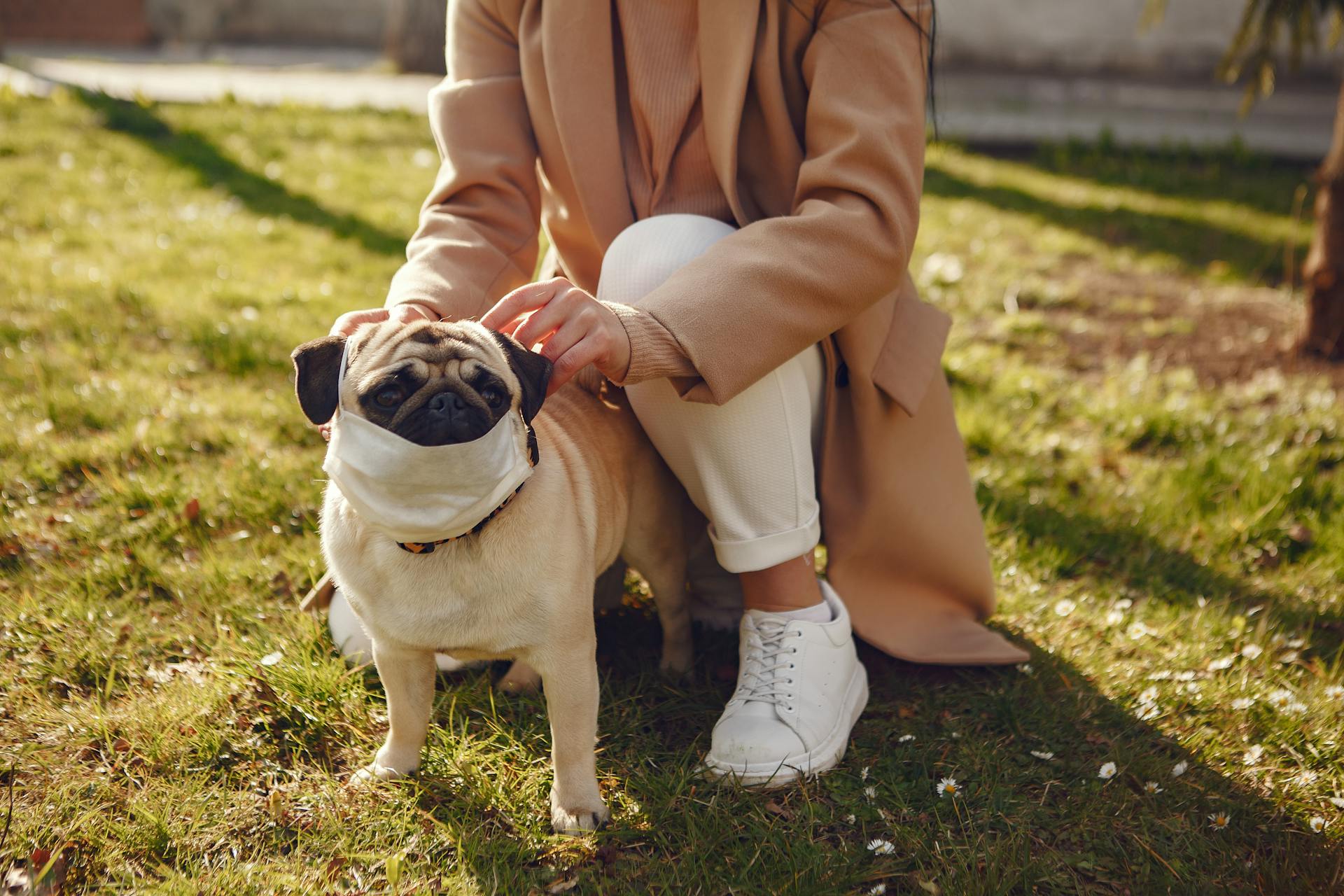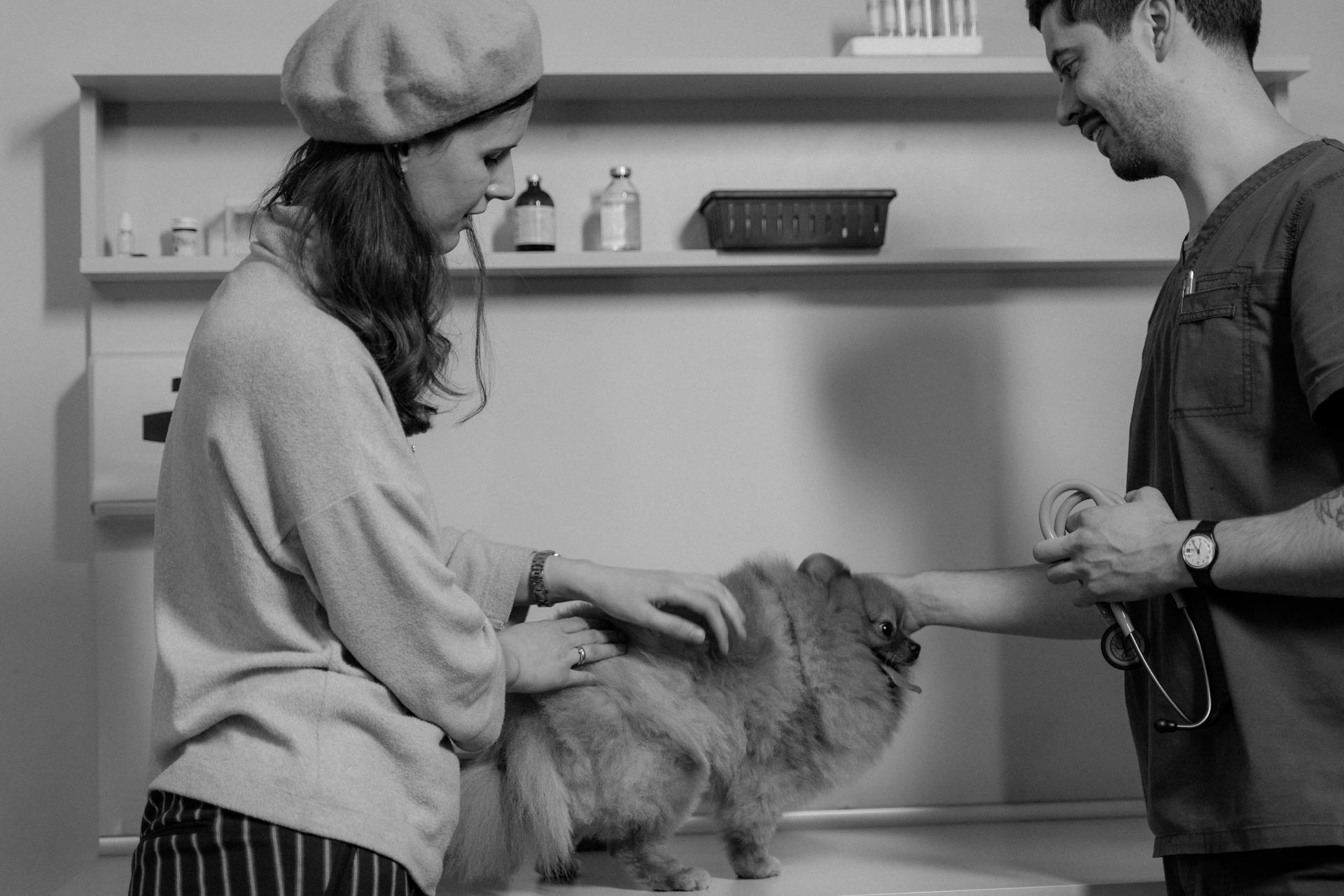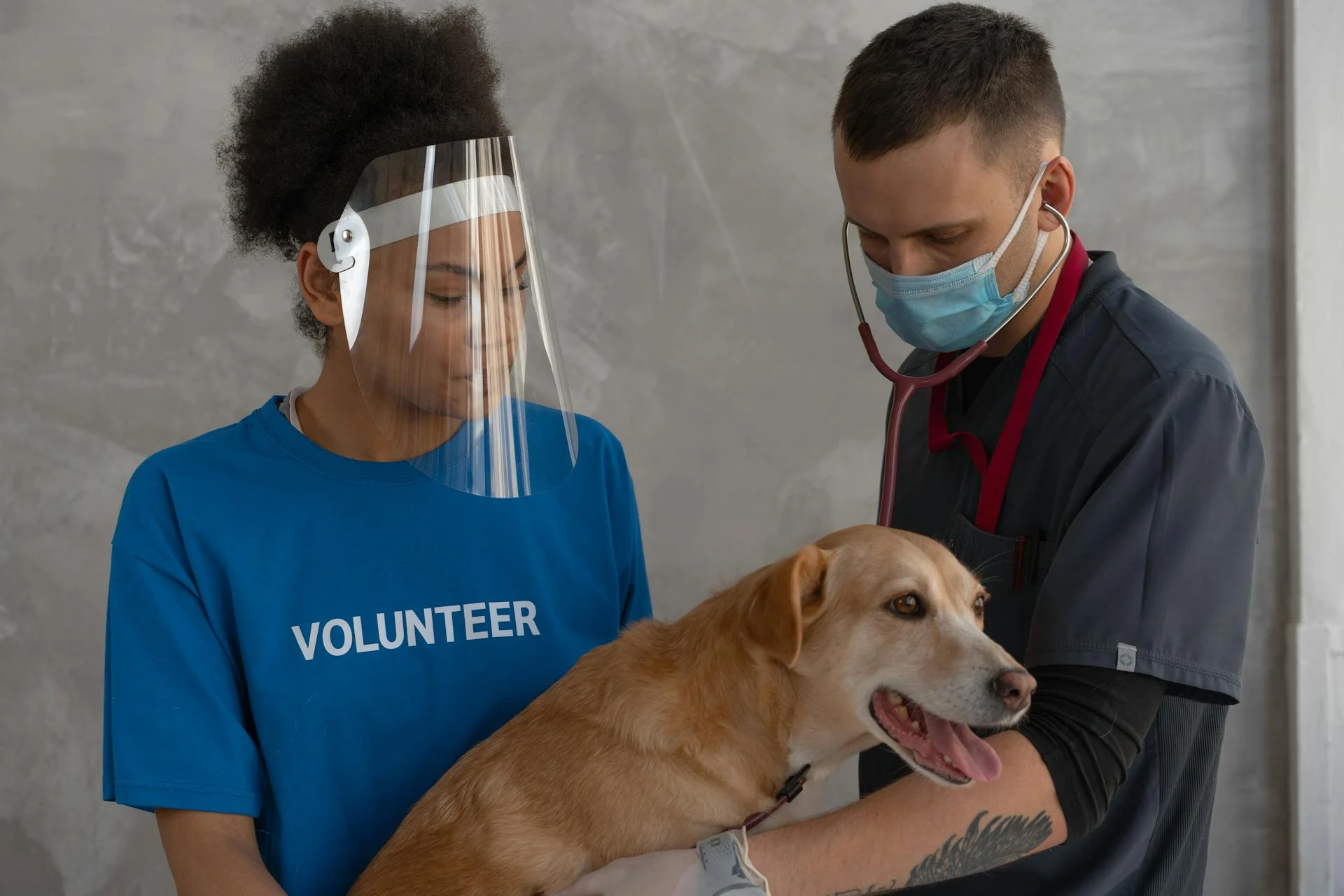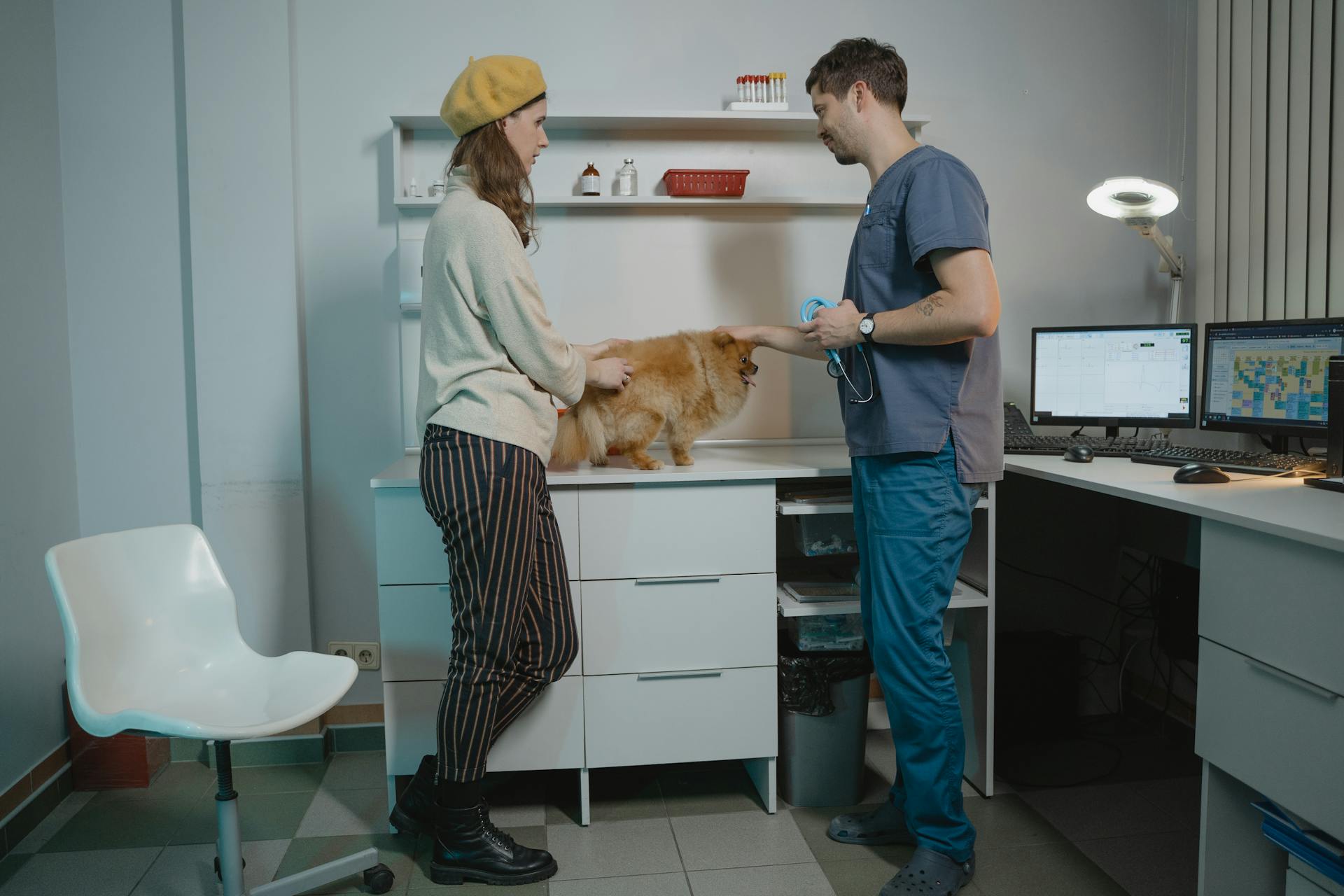
Collecting a urine sample from a female dog can be a daunting task, but with the right approach, it can be done successfully.
The best time to collect a urine sample from a female dog is after she has finished eating and drinking, as this will help her relax and make the process easier.
It's essential to use a clean and sterile container to collect the urine sample to prevent contamination.
Broaden your view: Urine Sample
Equipment Needed
To get a urine sample from your female dog, you'll need some specific equipment.
A tray is a must-have for catching your dog's urine, or you can use some tin foil as a makeshift substitute.
You'll also need plastic gloves to protect yourself from any potential mess.
A sample tube or pot is necessary for collecting the urine sample.
If you want to make the process easier, consider using a lead to keep your dog in place.
You'll also need a pen for labelling the sample tube.
Collecting a Urine Sample
Collecting a urine sample from your female dog can be a bit tricky, but with some practice and patience, you'll be a pro in no time. Use a flat and shallow container, such as a saucer or aluminum pie plate, to collect the urine and prevent spillage.
Your dog may not be comfortable around a urine collection container, so it's a good idea to train her to get used to it beforehand. Place the container near her food dish or use treats and petting to create positive associations.
If your dog is uncooperative, work with a partner for assistance. While you hold the leash, your partner can get behind or beside the dog to collect the urine. Wear disposable rubber/latex gloves before dog urine collection to maintain hygiene.
To make the process easier, consider training your dog to urinate on cue. This will give you better control and make sample collection convenient. Patience and positive reinforcement will make your dog feel safe and cooperate with you.
Here are some tips to keep in mind:
- Collect the whole sample in one go – avoid collecting small amounts each time your dog pees.
- If your dog won’t pee while on the lead, then allow them to be off lead as usual, but make sure you stay close to them so you don’t miss the sample.
- Ask your vet how much urine they need in the sample, often you won’t need to fill the whole pot.
Remember, collecting a urine sample from your female dog may differ from collecting one from a male dog due to their anatomy and how they are trained to urinate.
Collecting Dog Urine: Why It's Necessary
Collecting dog urine is necessary to help your veterinarian get a clear picture of your dog's health. A urinalysis can alert your vet to blood in the urine, diabetes, and even urinary tract infections.
Urinalysis is a test that looks for chemical properties or other signs that something isn't working right. It's most often performed to see how the kidneys and urinary system are functioning.
Your veterinarian will not have a full understanding of how your dog's body is working without this test.
If this caught your attention, see: How to Get Water Out of Your Dog's Ear?
Collection Process
If you're trying to collect a urine sample from your female dog, it's essential to do it correctly to get a clean and accurate sample. Use a flat, narrow container, such as a saucer, aluminum pie plate, or plastic container lid, under their body to collect the urine and prevent spillage.
You can also use a ladle to collect the sample midstream, which is a great option if you're not sure if your dog will squat or not. Don't worry if your dog is uncooperative, working with a partner can help make the process easier.
To make urine collection less stressful for both you and your dog, try training them to get comfortable with the urine collection device or container prior to urine collection. Place it near their food dish, or use treats and petting to create positive associations.
If you're having trouble getting your dog to urinate in your presence, spend time with them while they urinate for one or two weeks before collection. Use potty training basics, praise, and rewards to make them comfortable.
Here are some tips to keep in mind when collecting urine from your female dog:
- Use a flat, narrow container to collect the urine and prevent spillage.
- Consider using a ladle to collect the sample midstream.
- Train your dog to get comfortable with the urine collection device or container.
- Spend time with your dog while they urinate to make them comfortable.
Handling and Tips
Handling a urine sample from your female dog requires some care to prevent spills and contamination. Cover the container as soon as possible to keep the sample fresh.
If you're unable to take the sample to your vet's office right away, store it in a cool place like the fridge or on ice in a small cooler. This will help keep the sample stable until you can get it to the vet.
Don't worry if you don't get a large urine sample - your vet only needs about one tablespoon of urine to perform the urinalysis. This makes the process less stressful for both you and your dog.
It's also a good idea to give your female dog some verbal praise and extra petting after collecting the urine. This can help make the experience more positive for her.
Handling
Handling a urine sample requires some care to ensure it remains fresh and accurate. Cover the container as soon as possible to prevent the urine from spilling out or getting contaminated.
To prevent contamination, use a matching lid if your container has one. This will help keep the sample clean and safe.

After collecting the urine sample, take it to your vet's office as soon as you can. A fresh urine sample will provide the most accurate urinalysis results.
Ideally, the urine should be examined either immediately or within a few hours of collection. If you can't drop off the urine sample right away, you'll need to store it at your home until your appointment.
To store the urine sample at home, place it in your fridge or on ice in a small cooler. This will help keep the urine cool and prevent it from spoiling.
Here are some tips for storing the urine sample:
Tips
When collecting your dog's urine, it's a good idea to use a non-retractable leash so they can't walk far away from you. This will make the process much easier and less stressful for both you and your dog.
You don't need a large urine sample to perform a urinalysis. In fact, your vet will only need about one tablespoon of urine.
On a similar theme: Dog Names Female Start with S

Some dogs may not be comfortable around urine collection containers, so it's a good idea to train them to get comfortable with the device before collection. You can try placing it near their food dish or using treats and petting to create positive associations.
Here are some tips to make urine collection easier:
- Train your dog to get comfortable with the urine collection device or container prior to urine collection.
- Use potty training basics, praise, and rewards to make them comfortable while they urinate in your presence.
- Consider training your dog to urinate on cue to have better control and make sample collection convenient.
- Consider buying a urine collector device with a telescopic pole for easy sample collection.
Easy Collection Tips
Handling and Tips can be a breeze if you know the right tricks. Cover the container as soon as you can to prevent the urine from spilling out or getting contaminated.
To make collection easier, use a non-retractable leash so your dog can't walk far away from you. This will help you avoid chasing your pet around. If you have a retractable leash, keep it locked at a length that won’t allow your dog to walk far ahead of you.
Don't worry if you don't get a large urine sample. Your vet will need only about one tablespoon of urine to perform the urinalysis. This makes the process much less stressful for both you and your furry friend.
See what others are reading: Will Spaying a Female Dog Calm Them down

Training your dog to get comfortable with the urine collection device or container prior to urine collection can make a big difference. Try placing it near their food dish, or use treats and petting to create positive associations.
Here are some helpful tips to make urine collection easy:
- Use a short leash when taking your dog outside to urinate.
- Wear disposable rubber/latex gloves before dog urine collection to maintain hygiene.
- When your dog is urinating, slip a clean container or a ladle under them to collect the urine sample midstream.
- If your dog is uncooperative, work with a partner for assistance.
- Wash your hands thoroughly after collecting.
Collecting urine from male and female dogs may differ due to their anatomy and how they are trained to urinate. For female dogs, use a flat, narrow container under their body to collect the urine and prevent spillage. Alternatively, you can use a ladle to collect the sample midstream.
Sources
- https://www.pdsa.org.uk/pet-help-and-advice/pet-health-hub/other-veterinary-advice/how-to-collect-a-urine-sample-from-your-dog
- https://www.preventivevet.com/dogs/going-to-the-vet-how-to-collect-your-dogs-urine-sample
- https://www.ovrs.com/blog/how-to-collect-a-urine-sample-from-your-dog/
- https://www.wikihow.com/Get-a-Urine-Sample-from-a-Female-Dog
- https://www.diagnoxhealth.com/blog/how-to-get-a-urine-sample-from-a-dog-at-home
Featured Images: pexels.com


